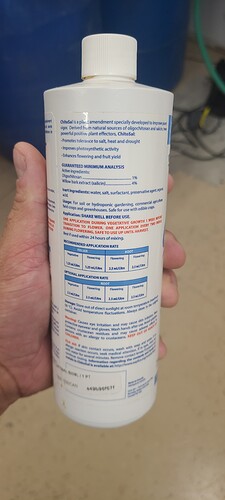Joe-ganics (biodynatural probiorganics)
(A hybrid of probiotic farming, biodynamic farming, korean natural farming and just regular organic farming)
I will try to keep shit simple for my sanity(since my stroke I still have issues with words and shit) and to make shit super simple for everyone!
I learned they trial and error, first using fuck farm the first grow (2010) and learned their nutes weren’t organic so I learned about teas, then learned about amending soil, then mixing my own soil, and then learned ability lactic acid bacteria serum, an amazing thing. I learned I could convert plants into nutrients
Then I learned I could look up what nutrients were in plants to extract,
Then I learned you can look at plants and see what part you want for what purpose.
ie if you see a green fast growing plant, like stinging nettles, it has whatever green plants need, in the correct ratios, to facilliatate a fast ass healthy growing plant.
Adding LABS(lactic acid bacteria serum) to stinging nettles will make a fertilizer that has tons of micronutrients, N,Ca, etc, all bioavailable to the plants.
And the trick to maximizing this is to use a tool of the hydro grower… a PPM pen. Every ferment is different based on location and what the plant was available to get(nettles are dynamic nutrient accumulators). Testing to dilute is necessary, start small and go up from there, depending on the plants ability to accept nutes(you can burn like this if you go too high)
So this is a veg (and all around) fertilizer, that has a lot of the trace minerals and shit.
You can use garden waste… look up what you grow and what the plant contains
I wanted to make a plant called “more kale bell” as a super calcium supplement
Yet I digress, and I forgot where I was going.
One tea I use(thanks coots or whoever he was when I read it) is a cup of alfalfa and 1/4c of kelp per 5gal water and bubble for 24-36h and dilute 50/50 and apply foliar until the first or 2nd week of flower. Alfalfa has tricontinal and N and kelp is a powerhouse of amazing shit
Shit to look up if I forget to write it down:
Dr dukes chemical and ethnobotanical database: where you can look up a plant and find out what it contains and where(ie in the root)
Beets for flower.
Ok, the basis of this shit, scientifically, is that if you make a batch of water and plant matter, and inoculate if with LABS, the bacteria eat the nutrients, the elements and shit, and store it in their body, I think, and when they die it is plant available.
In the soil the bacteria and fungi eat the nutrients and then trade it with the plant roots for exudates(plant sugar). It’s like a black market, bioavailable nutrients the plant wants at that time, for the sugar.
I’ve always used this to add to the living organic soil , so you have to give the plant what it wants at the time.
LABS
2c of rice in a half gallon of water… shake it for 10 min and decant.
Allow the starch and bacteria water to sit for a couple days,2-5 days, you’ll see a scummy bottom layer, a shitty top layer, and a clean middle layer .
Separate them if you want to!
Add to 4 gallons of organic milk!
Cover but don’t close the lid(I use cheesecloth on a 5 gallon bucket).
4-5 days at room temp or warmer, the curds(I believe calcium caseinate ) separates from the whey.
Separate them. The liquid is labs(the bacteria in the rice were put into the milk and only those who could I think regulate their own pH during it becoming acid are faculties anaerobes and lived to do the shit) the solid can be cheese but it’s super bland, great for chickens to eat! Dogs too! Nutritious and probiotic).
Google this shit, it accelerates composting, clogs drains, makes composting toilets not stink, and ferments plants into fertilizer.
I add a splash or three to a jug of shit to ferment, it only takes a little as they reproduce fast but I always make a lot so I use a lot!
I will write some more when I get the ch…
Fuck I can talk to the phone and it will type it, I forgot…
Basically, green plants have shit for veg.
Fast growing tips of green plants like blackberry etc have fast growing shit and hormones.
Yellow green red Orange and purple shirt are great for flower(beets are amazing, papaya, banana, carrots, ) and flowers and fruits for flowering and fruiting, and greens for greening.
Medicinal qualities also translate into medicinal for plants…ie alotiin in comfrey helps bones regrow but also increases cell enlingatiin in plants which grow thicker flowers. I think that’s why comfrey does so well in addition to P and K
Root veg like beets have P which is kinda hard to get from plants(I use fish bone meal in soil not bone meal from gmo cows killed in slaughterhouses but to each their own)
IPM
Most aromatic herbs are awesome pesticides. Rotate them, use your own or local wildcrafted if possible.
(Thanks again coot)
A cup or two o(packed) of herbs, add that and a couple cups of water, blender that shit, add to 4 gal water, bubble it for a day, filter and spray. Coriander, Rosemary, lavendula, thyme etc.
Google what your problem is when you have it and go accordingly or just rotate to keep shit on point.
250-300 of horsetail ferment (lots of bioavailable silica, it’s more against pathogens than pests)
If anything is unclear please let me know and I’ll try to correct it or you can .
Ask anything or add what you want!

